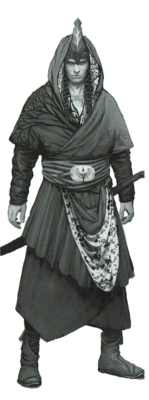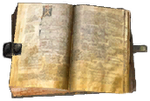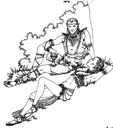Template:Infobox specieTemplate:BigQuoteElves are one of the humanoid races that inhabit the Continent. Forming a major part of the Elder Races (along with dwarves and gnomes), those known as Aen Seidhe came to the Continent on their white ships much earlier than humans, but later than the other Elder Races. They live much longer than humans and are usually very attractive.
Elves are capable of interbreeding with humans (thus producing half-elves and quadroons) and dryads. Though elves are incredibly long lived, only young elves are fertile, thus elven populations tend to reproduce at a slower rate than humans.[1]
Like other nonhumans, elves are often persecuted by Nordlings. Because of that, many elves were members of the Scoia'tael guerillas allied with Nilfgaard during the empire's invasion of the Northern Kingdoms. In return, Emperor Emhyr var Emreis gave the elves a state of their own in Dol Blathanna and made Enid an Gleanna its queen.
Elves believe that they were created, unlike humans, who evolved. For this reason, some elves consider humans to be little more than hairless apes. Aside from Aen Seidhe, there exists another group of elves called Aen Elle that inhabits another world.
Appearance
Characteristic features of elves include pointed ears and small, identical teeth without cuspids (canine teeth). Elves tend to be very tall and lean, and due to their longevity often appear youthful. Elves are often considered attractive by humans. Like humans, Elves choose to wear a variety of different clothing styles, although Scoia'tael are known to favor furs and hides, particularly those of squirrels and other forest dwelling creatures.[2]
Culture

Typical elven soldier (not Scoia´tael)
The elven culture places much emphasis on naturalism and living in harmony with the land, rather than bending it to one's will. Urban elves tend to be very scholarly or artistic, but can take up a variety of professions just like humans. Rural elves that do not live amongst humans live a somewhat simpler lifestyle, hunting, gathering, and living off the land as needed. In battle, elven warriors favor bows and metal swords, as well as light armor made out of furs and hides. They tend to be skilled at sword fighting from horseback.[3]
Language
Most elves speak Elder Speech, the traditional language of the Aen Seidhe. Almost all elves have at least have a rudimentary familiarity with Common Speech, but many, particularly city dwelling elves speak the common tongue just as well as any other human.
Technology
It appears many elven clans in the North have a tradition of hunting and gathering, as elves of Dol Blathanna are unfamiliar with agriculture and concepts such as crop rotation.[4] Though many now are destroyed, elves were once capable of making great cities and palaces out of stone, but they did not make castles or fortresses.[5] However many are destroyed or occupied and altered by humans.[1]
Society
Elves created magnificent towns and palaces before the arrival of humans to the continent, and many modern human cities including Novigrad, Oxenfurt, Vizima, Tretogor, Maribor, Cidaris, and the city of Cintra are built on the ground of destroyed elven cities.[5] Many elves and half elves have managed to integrate into human society but are still faced with prejudice on a day-to-day basis. Others have chosen to live in the wilds in secluded clans, living off the land and avoiding all contact with humans if possible.
Known representatives
Notable elves
Other known elves
In the graphic novels
The Witcher
Glossary Entry

|
Elves
|
Source
The Witcher 2: Assassins of Kings
Journal entry
- Elves, or Aen Seidhe, as they call themselves, are a folk known for their beauty and longevity. Their sages, scholars, and artists were at the fore of their fields, creating real, breathtaking masterpieces. The glory of this Elder Race is long gone, however. After a series of bloody conflicts with humans, their cities were ruined, and the elves themselves were forced to retreat to the east, into unapproachable mountains, or to recognize human domination and accept their lot. Years of wars, persecution, and mutual enmity created a rift between our races. Many elves saw a chance of winning freedom in the last war against Nilfgaard, so they took up arms, creating the partisan groups of Scoia'tael. Though they managed to secure the creation of the partially independent realm of Dol Blathanna, some feel they were deceived and still wage war on humans.
Notable elves
The Witcher 3: Wild Hunt
Notable elves
|
Gallery
Notes & references
- ↑ 1.0 1.1 The Blood of Elves US Edition, pg. 196
- ↑ The Blood of Elves US Edition, pg. 148
- ↑ The Blood of Elves US Edition, pg. 203
- ↑ The Last Wish US Edition, pg. 245
- ↑ 5.0 5.1 The Blood of Elves US Edition, pg. 194
- ↑ There is an Aideen in the books. She is a mentioned-only, human historical character, not the same person.


